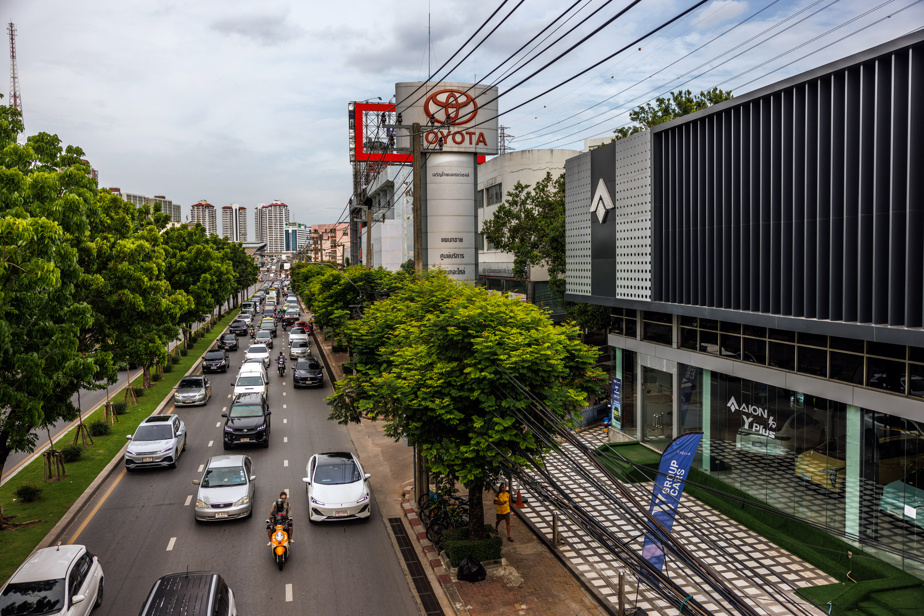(Bangkok) Japanese companies built Thailand’s automobile industry from scratch in the 1960s. By 1980, 90% of cars sold in Thailand were Japanese brands. The Japanese invested in local suppliers and their cars were known to be reliable.
After 1990, American and South Korean competition targeted the Thai market, but without much success.
Today, Chinese manufacturers are carving out a niche for themselves with something the Japanese don’t offer: cheap electric cars. For the past two years, imports from Chinese brands BYD, Great Wall Motor and SAIC Motor have been shaking up Japanese manufacturers.
Thai Prime Minister Srettha Thavisin visited Japan in December with a message for Japanese companies: Invest now in electric cars or China will beat you.
“You are not alone in the world,” Mr. Thavisin warned in an interview with Japanese media.

PHOTO LAUREN DECICCA, THE NEW YORK TIMES ARCHIVES
Assemblers at work on the chassis of an electric car at the GAC Aion plant in Rayong, Thailand
Initial skepticism among automakers about electric cars, which are very popular in Thailand, has caused Mazda, Mitsubishi, Nissan, Suzuki and Isuzu to lose ground, as they have been hit hard by their limited offering of plug-in hybrid or all-electric models.
Last year, their sales in Thailand fell by 25% (the country’s car market fell by 9%) according to MarkLines, an automotive information provider.
In July, Honda announced it would cease operations at one of its two factories in Thailand by 2025. Suzuki announced in June that it would close its only factory in the country.
Japanese automakers, which still hold 75% of the Thai market, are taking steps to reverse their decline. During Thavisin’s trip to Japan, Toyota, Honda, Isuzu and Mitsubishi announced investments of $4.3 billion over five years to convert their Thai factories to electric vehicles. By the end of 2023, Honda produced its first electric cars in Thailand.
A presence for 40 years
Nissan opened the first Japanese car plant in Thailand in Bangkok in 1962. At the time, Thais were buying only a few thousand vehicles a year. Toyota followed in 1964.
Japanese companies soon identified Thailand as an export hub for Southeast Asia, investing for decades to establish networks of suppliers and distributors in the country, especially for passenger vehicles. pickupsold at home and abroad. Japan’s strategy paid off in the 1980s and 1990s in particular, with demand booming in Southeast Asia as the United States and Germany focused on Eastern Europe.
Southeast Asia, including Thailand, is the main market for Mitsubishi and other smaller Japanese automakers. In the financial year that ended in March, Mitsubishi’s sales there fell 9 percent from a year earlier.
Japanese automakers are banking on hybrid and electric vehicles to regain lost ground. In February, Mitsubishi unveiled a hybrid version of its Xpander SUV in Thailand. The company says orders are already exceeding its expectations.

PHOTO PROVIDED BY MITSUBISHI
Mitsubishi has presented a hybrid version of its Xpander SUV in Thailand.
But Chinese manufacturers are formidable competitors.
Electric taxi
GAC Aion, the electric subsidiary of state-owned Guangzhou Automobile Group, has opened a factory and established a sales network in Thailand. It is trying to penetrate a Japanese stronghold: taxis. Almost all taxis in Thailand are Toyotas.
With local partner Gold Integrate, GAC Aion has launched an all-electric sedan aimed exclusively at the ride-sharing and taxi market.

PHOTO LAUREN DECICCA, THE NEW YORK TIMES ARCHIVES
Gold Integrate Chairman Huang Yongjie
Over the past year, several thousand of this model have been sold, selling for around $25,000 with a nine-year warranty.
According to Huang Yongjie, chairman of Gold Integrate, which also has investments in 15 Aion dealerships, Toyota responded to Aion’s entry into the Thai market by cutting the price of its main taxi model by nearly $3,000.
That’s remarkable, Mr. Huang said, because “Toyota never lowers its prices.”
This article was originally published in the New York Times.
Read the original article from New York Times (in English, subscription required)
